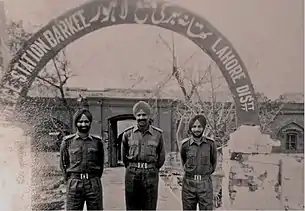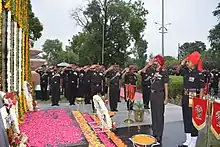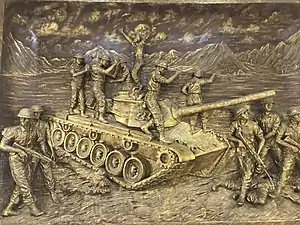| Battle of Burki | |||||||
|---|---|---|---|---|---|---|---|
| Part of the Indo-Pakistani War of 1965 | |||||||
|
| |||||||
| |||||||
| Belligerents | |||||||
|
|
| ||||||
| Commanders and leaders | |||||||
|
|
| ||||||
| Units involved | |||||||
|
7th Infantry Division[5] 48th Infantry Brigade 65th Infantry Brigade 5 Guards Central India Horse 9 Madras[6] 4 Sikh[7] 16 Punjab[8] 6/8 Gorkha Rifles |
10th Infantry Division
| ||||||
| Strength | |||||||
|
1 infantry division[1] 1 armoured regiment[11] |
(3 Regiments) 2 Companies of 17 Punjab Regiment 10 F-86 Sabre jets | ||||||
| Casualties and losses | |||||||
| 4 tanks destroyed (Indian claim)[3] | 84 tanks captured or destroyed (Indian claim)[3] | ||||||
The Battle of Burki was a battle fought by Indian infantry and Pakistani armour in the Indo-Pakistani War of 1965.[3] Burki (also spelled Barki, Burkee and Barkee) is a village, that lies south-east of Lahore near the border with Punjab. For reference, that is just 11 km from the Allama Iqbal International Airport in Lahore, and is connected to Lahore by the a bridge over the Bambawali-Ravi-Bedian (BRB) Canal.[12] During the battle, the strength of the two sides were relatively even. Indian infantry clashed with Pakistani forces that were entrenched in pillboxes, dug-outs and slit trenches that had been carved into the canal banks. The Pakistanis were supported by a large number of tanks, as well as fighter jets.[3] The battle resulted in an Indian victory.[3][4]

Background
Pakistan launched Operation Grand Slam on 17 August 1965 in an effort to relieve infiltrators who had been surrounded after the failure of Operation Gibraltar on 15 August and to attempt to cut off the Indian supply lines.[13] With supply lines under severe stress due to Operation Grand Slam, India launched an offensive towards Lahore to open up a second front in the war and distract Pakistani attention from Kashmir.[13] After opening the Lahore Front, Indian troops advanced towards Lahore along three axes – the Amritsar-Lahore, Khalra-Burki-Lahore and Khem Karan-Kasur roads – overwhelming the small Pakistani force.[14]
Indian infantry, supported by the only Indian armoured division, quickly pushed back unprepared Pakistani defenders with the aim of encircling and possibly besieging Lahore. Due to the element of surprise, India was able to capture a large amount of Pakistani territory from the town of Khalra, an Indian border town which lies on a straight road to Lahore through Burki.[2][3] In the meantime, the Pakistani Army mobilised the troops in the region and mounted a three-pronged counter-attack to recapture lost ground. The Battle of Burki was subsequently fought on Khalra-Burki-Lahore road.[3][14]
Pakistan's main goal was to force the Indian infantry into retreat before their armoured support and supply lines could catch up. The Pakistani Army's aim also was to capture much of the territory it had lost earlier in the fighting.[2] The Indian infantry's aim was to capture and hold the town of Burki until reinforcements, including armour and supplies, could arrive.[1][2][4]
Battle

India began their advance from Khalra under Major-General Har Krishan Sibal and tank operations under Lieutenant-Colonel Anant Singh with a village called Jahman being the first major Pakistani outpost to fall.[2] Pakistani troops pulled back towards the next major town, which was Burki, leaving small pockets of resistance at each village to slow down Indian advance.[16]
On 8 September, Pakistan began the counter-attack with Pakistani artillery pounding the Indian advance on 8, 9 and 10 September.[2] The constant shelling slowed down the Indian advance but failed to stop it completely.[2] This was followed by a counterattack by Pakistani armour consisting of a considerable part of Pakistan's 1st Armoured Division.[1] Indian infantry eventually clashed with Pakistani tanks at Burki, which resulted in most of the Pakistani armour being damaged or destroyed by 10 September.[3]
The Indian infantry was able to hold off the Pakistani armoured units until Indian tanks from the 18th Cavalry Regiment arrived. They were then able to subsequently launch the main assault on 10 September with armour support. As most of the Pakistani tanks had already been lost, the Pakistani defenders had little armoured support from the remaining tanks. A few Pakistani fighter jets were called in to provide air cover for Pakistani troops and to target Indian positions.[4] However, the use of fighters to perform strafing against ground troops instead of bombers meant that little was achieved through air support.[4] The limited number of jets and the easy availability of trenches and defensive structures for cover added to the ineffectiveness of Pakistani air operations. As a result, after intense fighting, the Indian army captured Burki on 11 September and held it throughout the rest of the war.[4]
Aftermath
After the capture of Burki, the Indian advance continued towards Dograi, a town in the immediate vicinity of Lahore. The town and surrounding areas were captured on 22 September, bringing the city of Lahore within range of Indian tank fire. Despite the Indian Army's capture of the Burki sector through the Bambawali-Ravi-Bedian Canal, the outnumbered military companies under Major Raja Aziz Bhatti had forced the Indian Army to engage in hand-to-hand combat during the night of the 7–8 September 1965, and the fighting continued through the next three days despite the Indian Army's numerical advantage. Subsequently, the Indian Army's armour columns had to halt their plans of capturing Lahore and instead focus on securing the Burki sector as well as destroying the bridge connecting the Bambawali-Ravi-Bedian Canal.[17][18]

Awards
Battle Honour of Barki and Theatre honour of Punjab 1965 was conferred on the following Indian units[19][20] -
- 16 Punjab
- 4 Sikh
- 9 Madras
- 5 Guards
The Pakistani commander, Major Raja Aziz Bhatti was later posthumously awarded the Nishan-e-Haider, the highest military decoration given by Pakistan.[21]
See also
- Battle of Kasur (1965)
- Battle of Chawinda
- Pathankot airstrike
References
- 1 2 3 4 Capt, Ranbir Singh Gp (2005), Major Defence Operations Since 1947, Ocean Books, p. 100, ISBN 978-81-88322-67-1
- 1 2 3 4 5 6 7 Gupta, Hari Ram (1967). India-Pakistan war, 1965, Volume 1. Hariyana Prakashan. pp. 154–157 – via archive.org.
- 1 2 3 4 5 6 7 8 9 Melville de Mellow (28 November 1965). "Battle of Burki was another outstanding infantry operation". Sainik Samachar.
- 1 2 3 4 5 6 Singh, Gp Capt Ranbir (2009), Memorable War Stories, Ocean Books/Prabhat Prakashan, ISBN 978-81-88322-66-4
- ↑ "Wrong Timing the Battle: Khem Karan and Afghanistan". 23 October 2021. Retrieved 25 August 2022.
- ↑ "Capture of Barki by 4th Sikh" (PDF). 1 September 2015. Retrieved 25 August 2022.
- ↑ "Saragarhi Battalion to commemorate valour of its soldiers". The Times of India. 12 September 2019. Retrieved 25 August 2022.
- ↑ "Veterans celebrate Battle Honour Day". 12 September 2019. Retrieved 25 August 2022.
- ↑ "BATTLE HONOURS OF THE INDIAN ARMY – 18, 1965 INDO PAK WAR: BARKI, ASSAULTING THE ICHHOGIL CANAL". 2 April 2020. Retrieved 25 August 2022.
- ↑ Air Commodore Qadeer Ahmad Hashmi. "PAF in Defence of Lahore". DefenceJournal.com. Archived from the original on 23 September 2001.
- ↑ Das, Chand N. (1997), Hours of Glory: Famous battles of the Indian army, 1801–1971, Vision Books, p. 106, ISBN 9788170940692
- ↑ Gopal, Ram (1967), Indo-Pakistan war and peace, 1965, Pustak Kendra, p. 118
- 1 2 "Indo-Pakistan War of 1965". globalsecurity.org.
- 1 2 Johri, Sitaram (1967), The Indo-Pak Conflict of 1965, Himalaya Publications, pp. 129–130
- ↑ "Golden Arrow Division celebrated its 60th Raising Day at Barki War Memorial". 1 July 2022. Retrieved 25 August 2022.
- ↑ Saxena, K. C. (1966), Pakistan, Her Relation with India 1947–1966, Vir Publishing House, p. 169
- ↑ fgdd. The New Encyclopædia Britannica. Encyclopædia Britannica, 2002. ISBN 978-0-85229-787-2.
- ↑ "PAKISTAN ARMY". www.pakistanarmy.gov.pk. Retrieved 1 January 2022.
- ↑ "Golden Arrow Division celebrates Barki Day to commemorate 'Battle of Barki'". 10 September 2017. Retrieved 25 August 2022.
- ↑ "War memorial inaugurated". Tribune News service. 25 August 2010. Retrieved 7 April 2011.
- ↑ Illustrated Weekly of Pakistan. 1966. p. 9.